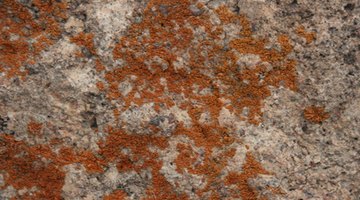List of Biocide Mold Removers
A biocide is an agent that destroys microorganisms, including mold. Some mold-removing biocides come in the form of generic chemicals, while others are produced by brand-name manufacturers. When employing biocides to kill mold, use caution as these strong chemical solutions may have toxic or abrasive qualities.

Removing mold with a biocide is only one treatment option, and sometimes only the beginning of the process in cases of large-scale mold problems.
Chlorine Bleach
A 5.25 percent concentration of sodium hypochlorite composes most varieties of standard household chlorine bleach, though some weaker varieties feature concentrations of .7, 1.8 and 2.4 percent sodium hypochlorite. Chlorine bleach's disinfectant properties kill mold, germs and mildew. This product's antimicrobal nature allows it to act as a mold-removing fungicide. The substance similarly acts as a pesticide, as well as an anti-bacteria and anti-virus agent. When using chlorine bleach as a biocide, never mix it with any other biocides or household cleaning products as doing so may result in the formation of harmful acids or poisonous gases. This commonly used and affordable biocide comes in liquid form and is available at most grocery stores.
SNiPER
The creators of SniPER at Global Environmental Restoration in Louisiana tout their product as “the ideal biocide.” This mold removal agent contains a 2,000 parts-per-million concentration of stabilized chlorine dioxide, allowing it to serve as an oxidizing biocide rather than a metabolic toxin. SNiPER works by disrupting the transport of nutrients across the cell walls of mold, killing its vital microorganisms. This product presents a somewhat safer and more environmentally-friendly biocide choice than others, as many organic compounds degrade chlorine dioxide over time. The United States Environmental Protection Agency recognizes this product as a mold-removing fungicide.
OxB Biocides
A product of the OxB Corporation, the OxB biocide works as a sanitizer, disinfectant, sterilant and “terror-fighter”—the latter term comes from the product's ability to fight the bio-terrorism agent anthrax. This “super oxidant” forms a stable complex ion that converts to free radicals in the presence of organic matter. In terms of mold, OxB removes it by acting as a sporicide active against all microbal forms, including microorganisms, vegetative and spore forms. OxB is effective against spores, bacteria, yeast, fungus and viruses. According to the manufacturers, toxicology tests show that OxB biocide is safe to human health. OxB biocide comes in aerosol, spray and liquid forms, each suitable for mold removal on different surfaces.
The Drip Cap
- A biocide is an agent that destroys microorganisms, including mold.
- When employing biocides to kill mold, use caution as these strong chemical solutions may have toxic or abrasive qualities.
- Removing mold with a biocide is only one treatment option, and sometimes only the beginning of the process in cases of large-scale mold problems.
- This commonly used and affordable biocide comes in liquid form and is available at most grocery stores.
- This mold removal agent contains a 2,000 parts-per-million concentration of stabilized chlorine dioxide, allowing it to serve as an oxidizing biocide rather than a metabolic toxin.
Resources
Writer Bio
Dan combines his decade-long experience as a freelance writer with hands-on experience in landscaping, flooring, painting, maritime maintenance and handy man work. Previously, he's published with Black+Decker, Geeks On Home, GardenGuides.com, GOBankingRates.com, USA Today, SFGate Home and others.
Photo Credits
- mold on petrified wood image by MAXFX from Fotolia.com
- mold on petrified wood image by MAXFX from Fotolia.com
More Articles



